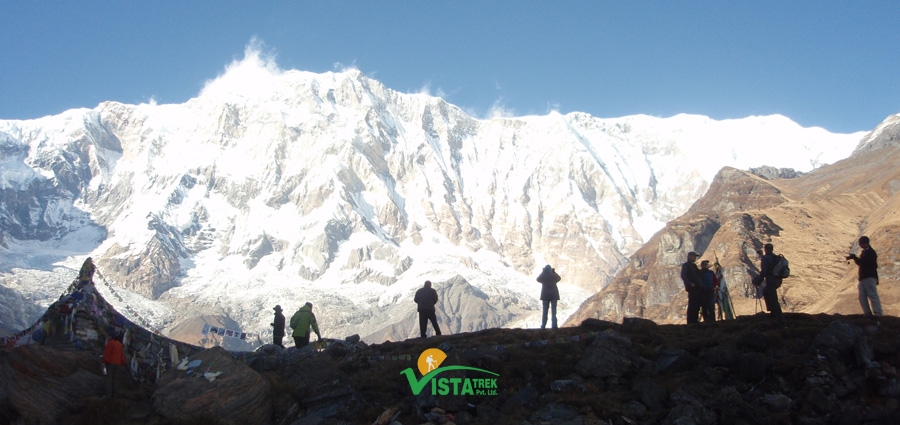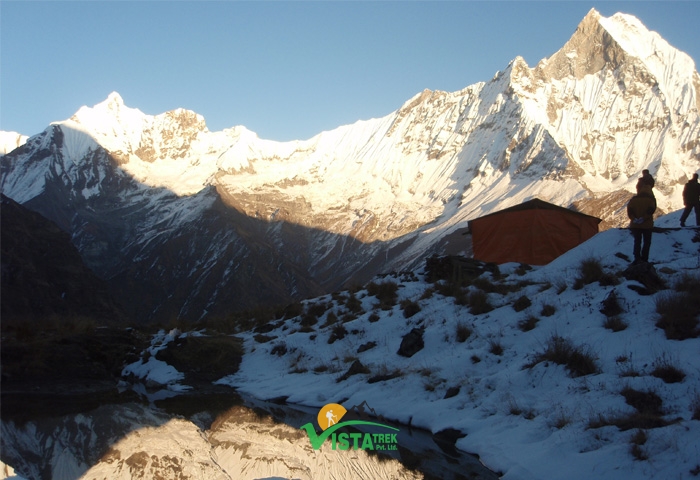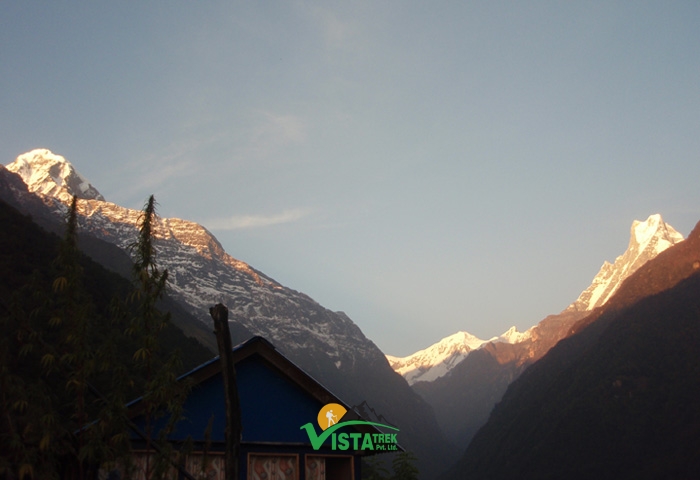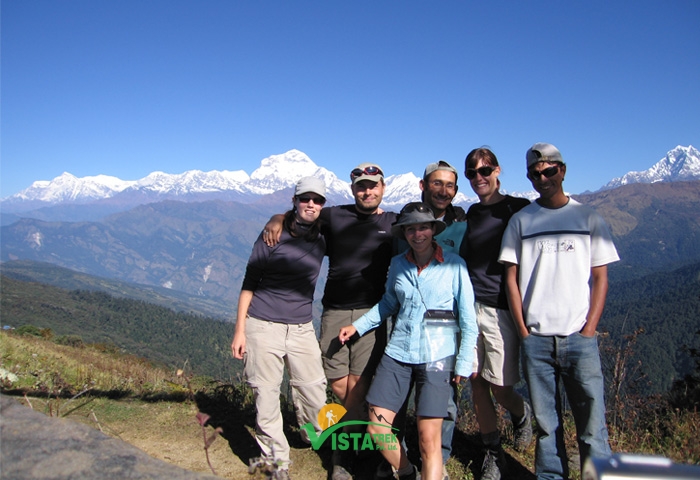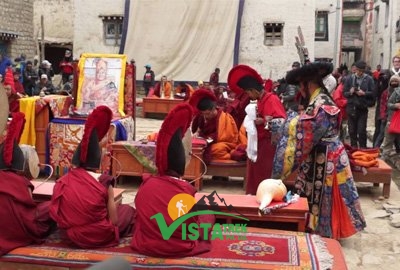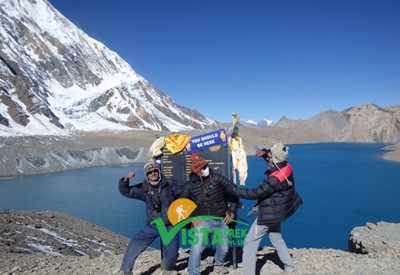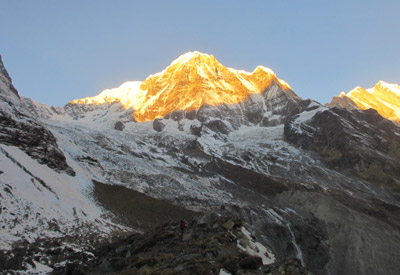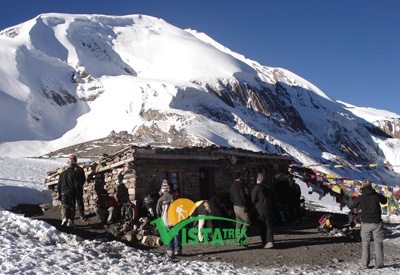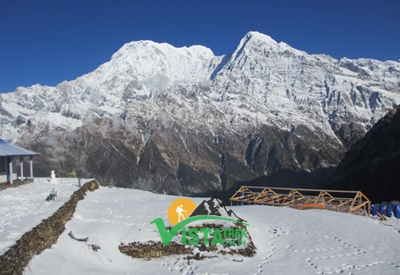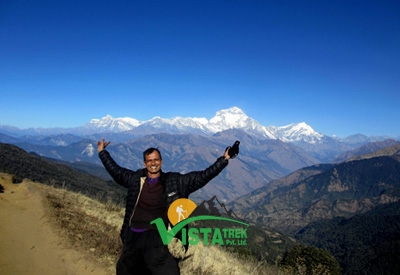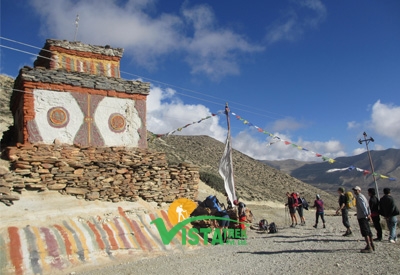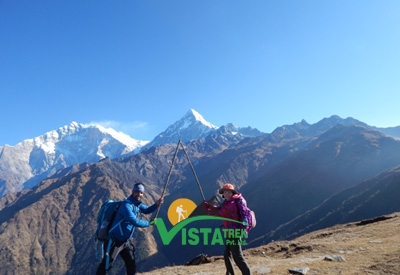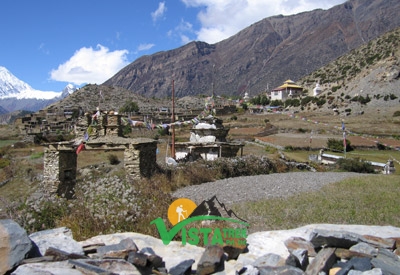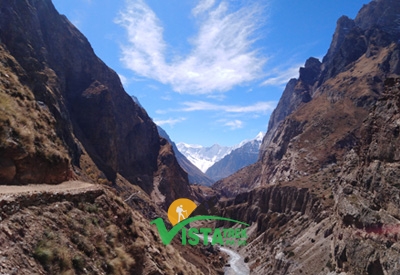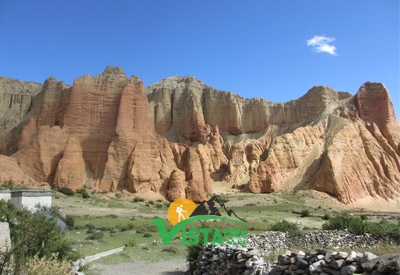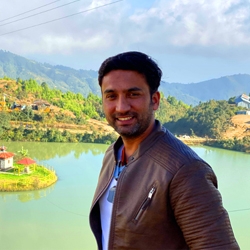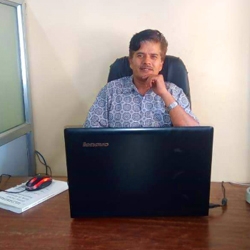Trip Facts
- Duration 13 Days
- Start FromKathmandu
- Group Size1-10 Pax
- End FromKathmandu
- Trip GradeEasy to Moderate
- Max Height 4130 m
- AccommodationTea House
Best Season
September – December & March to May
Trip Highlights
- Enjoy Magnificent views of many peaks including some that remain in the memories of many people for long: Mt Dhaulagiri, Mt Machhapuchré, the LamjungHimal, Annapurna II, III and IV
- Relish the Gurung culture and traditions along the trip
- Trek through lush forests of rhododendron and enjoy the serenity
- High altitude trek to Annapurna Base Camp (4,130 meters)
- Up close with one of the world’s highest (above 8000 meters): Mt Annapurna I
- Waterfalls a lot more in comparison.
Trip Overview
An iconic trip across the foothills of the Annapurna Himalayas, the Annapurna Base Camp Trek is one of the famous treks in Nepal. The trek stretches through the Gurung villages and introduces their culture and practices to the trekkers. Also, the trek explores the wonderful riches in the Annapurna Conservation Area. The trek also makes a detour to the famous Poon Hill where you can enjoy the surreal panorama of the mountains.
First of all, the 13-day trip starts from Kathmandu and heads to Pokhara. The mesmerizing Mt. Machhapuchhre (6997m) will welcome you to the City of Lakes before you drive to Nayapul. The trek begins as you head to Tikhedhunga and continue to Ulleri. Next on the journey is Ghorepani which is a village of Gurung and Magar inhabitants. Then, you will take a hike to the top of the Poon Hill vantage point. Here, you can enjoy the panorama of the Annapurna and Dhaulagiri Himalayas. Further, the trek heads northeast to Tadapani village.
Next, the trek heads north along the Modi River and reaches Sinuwa. Then, the gentle trail heads through lush forests to settle at Deurali. As the trip nears its final destination, you reach the Machhapuchhre Base Camp. Heading west from the base camp along icy trails, you reach the Annapurna Base Camp. Here, you can enjoy the beautiful panorama of the Annapurna Himalayas including the Annapurna I (8091m) itself. After exploring the famous trails on the Annapurna region, you will descend along the Modi River to Jhinu Danda. Here, you can rest in the natural hot water springs before heading to Nayapul and returning to Kathmandu.
Best time to visit Annapurna base camp:
Spring (March to May) and autumn (September to November) are the best seasons for the ABC trek. Moreover, the trek is a fairly easy one and trekkers with average fitness can complete it as well.
Note:
At Vista Treks, we offer the finest services to all our clients. The Itinerary of Annapurna Base Camp Trek is the standard one that follows by many travellers. However all the program can be customized according to your available time, interest and budget .
Trip Itinerary
- Upon arrival at Tribhuwan Intl Airport in Kathmandu, a representative from Vista Trek waiting, well in time, to receive you, shall welcome you to this land of the towering Himalayas. Once reaching your hotel in a car from the airport, all you need to do is check in and enjoy the refreshment served.
- We then visit the Vista Trek office for discussion on trekking, introduction to the guide and porter and settlement of dues if any. Since you often still have some time left for a walk around Thamel, you can do so if you please.
- We head off to Pokhara on a tourist bus early morning. On a highway carved along the foothills and along the banks of the famous Trishuli and Marshyndiriver, this almost 6-hour journey, with guaranteed two stops for breakfast and lunch comes to its final stop in Phokhara, the city of lakes.
- Spend the night in a hotel here.
- After breakfast, it’s time for an-hour-and-a-half drive to Nayapul, With Annapurna Range already in sight, the ride takes us through forests and villages that are typical along the highways in the hilly regions of Nepal.
- Once in Nayapul, we start trek and walk for about two and a half hours, stopping at Sudame Village for lunch. A gradual and comfortable uphill with quite a few waterfalls that, more often than not, make many a travelers’ day, the trail finally leads to Sudame – terraced fields, lovely people, wandering domestic animals, well-fed street dogs. The place happens to be a small village with a dozen or so households and this is where we stop for lunch.
- After lunch, we walk again for another two and a half hours to Ulleri. Continuing the gradual comfortable uphill for half an hour or so to Tikhedhunga Village and after crossing suspension bridges twice, the route, immediately changes to a steep painful uphill for the nexttwo hours on stone-paved paths towards Ulleri. On a clear day, Ulleri generously showcases the Himalayas in its proximity: the gradual blending of the massive Mt Annapurna South and an almost a replica, but smaller in size, Mt Hiunchuli.
- Spend the night here.
- After breakfast, we walk all the way to Nangethanti. For about an hour and a half until Banthanti, this walk comes as an uphill, the one not so sharp. The landscape, with terraced farms on hills, highlighting the presence of human settlement in villages pretty close, keeps most traversing the land updated about different ways of life people choose. There is some more to this, however. For anyone in motion, first Mt Annapurna South and Mt Hiunchuli appear then disappear behind the hills and, after a short while, Mt Machhapuchré (Fishtail) appears then the elevation too disappears from view before long. All the way through a dense rhododendron forest, we stop at Nangethanti for lunch.
- After lunch, we continue through the forest on similar routes to Ghorepani. As one of the better equipped settlements to serve the tourist, with restaurants, cafes, pool houses and gift shops, Ghorepani, nestled in the middle of this forest, also offers a beautiful surrounding. In spring, the whole forest is in bloom with rhododendron flowers, mostly in red, some in pink and white sporadic.
- At around 4 in the afternoon, we head off for Poon Hill. This one and a quarter of an hour journey uphill comes as taxing for many. Once atop Poon Hill, however, the sunset view, on a clear day, leaves none wanting for more: while the tops of the entire Annapurna Range glistens in shades of orange, the Dhaulagiri range opposite is more in the shadow and appears how it should in any normal dusk light. The walk back downhill from this vantage point takes most people around half an hour.
- Spend the night in here.
- Early morning and we walk to Poon Hill once again, but for a sunrise view this time around. The average period of one hour fifteen minutes spent on this vantage point in the early mornings presents everyone with a view that includes the glistening Dhaulagiri Range, the Annapurna Range opposite in shadow along with some incoming or outgoing Jomsom/Phokhharaaeroplanes flying past from a lower altitude.
- Once back in Ghorepani and it’s time for breakfast. After breakfast, we start walking to Tadapani. With a sharp uphill for two hours still through a rhododendron forest, the trail continues with the Annapurna South, Mt Dhaulagiri as well as the Fishtail still in view. After about 2 hours’ traversing, the route arrives at a ridge. With the fading of rhododendron forest, the walk, on the ridge lasts for roughly half an hour on gentle ups and downs. The next to follow is a two and a half hour downhill, through a forest once again, with a gorge sometimes to the left and at others to the right and sometimes along a stream that requires crossing wooden bridges at places. The next one and a half hour takes all travelers to Banthanti, a small settlement and our stopover for lunch. Lunch over and we walk the next half an hour further downhill until crossing a river. From here on, the climb is a sharp one all the way to Tadapani.
- Spend the night in this settlement.
- After breakfast, we walk for 3 hours to Gurjung. The first two hours is a steep downhill the kind that makes most not-so-used-to-the-terrain legs go wobbling. The only relief for many seems to be the greenery around and the smiling porters carrying loads one would, perhaps, not believe if not for one’s first hand presence. The decline ceases only after crossing a suspension bridge placed over KimrungKhola, but a sharp uphill for half an hour is what follows. Finally, a gradual uphill for another half an hour or so brings everyone to Gurjung for lunch.
- After lunch, we walk again for about 3 hours to Sinuwa. A sharp uphill leads the way for the first 30 minutes, followed by an almost flat path for the next 30 minutes to Chhomrong Village, a typical village found in the area and also a popular stopover for many tourists. A stop for tea or coffee or the popular Chhomrong pizzas and we get to see a closer view of Mt Annapurna South and Mt Hiunchuli right in front with Fishtail to the right front. We start again, a steep downhill of around 40 minutes on stone stairs. Once crossing ChhomrongKhola, the route turns a steep uphill for 70 or 80 odd minutes. Sinuwa, a small settlement with 3 constructions as of January 2016, is in place with one purpose: to facilitate tourism. Weather willing, a sunset view of Mt Hiunchuli and Mt Fishtail is a welcome relief for almost everyone.
- Spend the night here.
- After breakfast, we walk for nearly 3 hours to Dovan. For about an hour, the trail presents a balanced combination of those flats, uphills and downhills. It then changes to a downhill, first gradual then sharp, all the way to Bamboo Village for roughly two hours. Most legs find the next one hour or so a comfortable uphill, which also happens to bring everyone to Dovan for lunch. A small settlement with only a few constructions mainly to serve the trekkers, Dovan offers a lunch in the presence of the majestic Mt Machhapuchré (Fishtail) up close.
- After lunch, the walk now heads towards Deurali. The first 30 minutes is a gradual incline, followed by a 40-minute sharp uphill. The next 20 almost flattens out, mostly through parts of a forest, until Himalaya Hotel with two teahouses. From here on the route turns uphill, 20 minutes gradual, 40 minutes sharp, the gradual with the exception of a short 10 minute downhill. This landscape matches the one described just a while ago. As our destination closes in, WATERFALL, a big waterfall. This is the Deurali Waterfall, which appears to have emerged right from Mt Hiunchuli. Deurali, surrounded by rocky elevations with only a small portion of the peak of Mt Machhapuchré on display, houses four stone-n-wood constructions for tourists.
- Spend the night here.
- After breakfast, we walk for approximately two hours to Machhapuchré Base Camp (MBC). During this period, the vegetation sees a decline in trees, from dense to sparse, taken over by shrubs and grasses. The route is first a one-hour gradual uphill and the next one a sharper uphill, with Mt Gangapurna appearing right from the initial stages out of Deurali and other mountains, namely Mt Glacier Dom and Mt Annapurna III, joining in from a little further up. A tea break at MBC leaves everyone facing the magnificence of Mt Machhapuchré and the Annapurna South from a different angle.
- We start walking again after the break. After almost an hour up a sharp uphill, Annapurna I appears as soon as this uphill ends. The next hour eases off a little, less in sharpness than the one just before. Once in ABC, people often find themselves facing Annapurna South slightly to the right of Mt BarahaShikhar; to the right of this, the gaint Annapurna I; further right, Tent Peak also known as Tharpuchuli; to one’s right-back from this position, Annapurna III; to the back, Machhapuchré; to the left-back, numerous nameless rocky structures; to the left, Mt Hiunchuli and to top all this, the stunning sunset view of Mt Machhapuchré. On a clear night, especially, on a full moon positioned somewhere behind one of the peaks in the east, celestial bodies, including all those stars, appear closer and a lot more sparkling.
- The morning of this first day of our journey back starts with an early sunrise view, especially, of the gradual lightening up of first only the top, then half of the peaks of the Annapurna South and Annapurna I to the West. After breakfast, we walk back and stop for a tea break in Deurali, then for lunch in Himalaya Hotel. Today’s stopover for the night is the Bamboo Village.
- After a stop in Sinuwa for tea and Chhomrong for lunch, a sharp downhill finally takes us all to JhinuDanda. After checking in and some rest, we walk downhill, for only about 10 minutes, to the hot springs on the bank of Modi River.
- After breakfast, we first walk for 3 hours to Siway. A sharp downhill for the first 20 minutes, followed by a sharp uphill for the next 20, the trail from here on comes with gradual ups and downs all the way. Some additional attractions for all traversing are those several waterfalls and wild bee hives on the way.
- After lunch in Siway, this final two-to-two-n-a-half-hour is a ride on a public vehicle to Phokhara.
- We head off to Kathmandu on a tourist bus early morning. This almost six-hour journey passes through numerous important settlements with guaranteed two stops for breakfast and lunch. The bus ride finally comes to its stop in Kathmandu.
- Back in Kathmandu, and only your WILL shall dictate your involvement or indulgence as you may please since our arrival is in the afternoon.In the evening, however, please allow us the pleasure of your company during the fare-well dinner organized by Vista Trek.
- Spend the night in a hotel.
- If you have a morning flight, we leave for Tribhuwan Intl Airport early morning in a car arranged by the office.
- If your flight is in the late afternoon or evening, only your WILL shall dictate your involvement or indulgence as you may please before leaving for Tribhuwan Intl Airport in the vehicle.
Cost Includes
- Pick up and transfer by car from Airport-Hotel-Airport.
- 2 nights standard hotel accommodation in Kathmandu and 2 night in Pokhara as per the itinearay.
- Breakfast, lunch and dinner during the trek.
- Local lodges accommodation during the trek.
- Government licensed guide,plus experience porters ( including their food, salary, accommodation, equipment, medicine & insurance).
- All local transportation by car/bus as per the itinerary.
- All necessary permits and entry fees.
- Medical kit box
- Rescue assistance.
- All government taxes.
- Necessary equipment (sleeping bags, down jackets etc. if needed).
- Our service charge.
Cost Excludes
- Meals in Kathmandu & Pokhara.
- International airfare.
- Nepal entry visa fee ($40).
- Your travel insurance (should include your medical and rescue).
- Any personal expenses.
- Any kind of Hot & Cold Drinks during the trek.
- Staff & driver tipping.
Trip Map
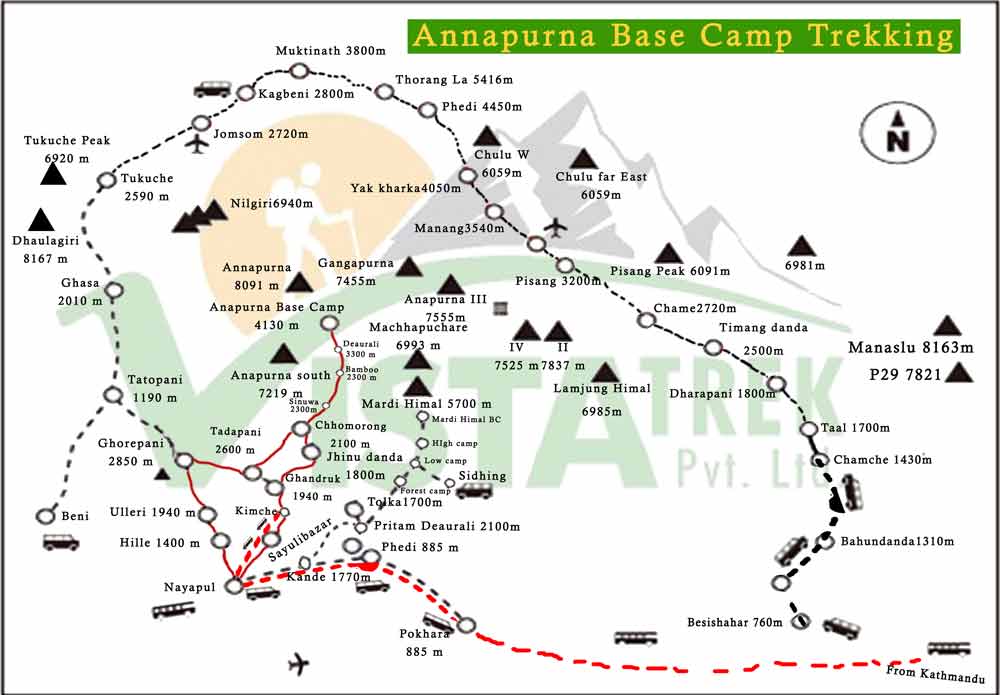
Useful Info
About Accommodation.
In Kathmandu, we will accommodate you at Hotel Sapana Garden, and In Pokhara at Hotel Splendid View or similar standard hotel. Local lodges accommodation provided during the trek on twin sharing basis. Hotel in Kathmandu and in Pokhara comes with private bathroom , however in mountain, toilet and shower will be on sharing basis. In the busy months, (October/November & April/ May) you may have to share the room with other traveler as some villages have limited number of local lodges .
About Meal
You can enjoy typical Nepali food as well as continental , Italian, Indian and Tibetan. Dinner and breakfast serve at the teahouse where we stay and lunch will be served on the way to next destination. In Kathmandu and in Pokhara, only breakfast is provided. If you are a vegetarian or vegan, no worries, Nepal is such a easy place to get several vegetarian options.
About Staff:
A Guide and a porter assist you from Kathmandu to Kathmandu. In a group with more than 8 clients, 2 guide will be provided. A porter provided for 2 trekkers, and carries between 15 to 20 K.G.
About Equipments
Following Equipment list is recommended to bring for the trek.
Down Sleeping Bag, Down Jacket, Long sleeved shirt, Jumper or fleecy jacket, T – shirts, Trekking shoes or boots, Comfy shoes for around the camp, thick and warm woolen socks, Light cotton socks , A day bag to carry your valuable, Sun hat, Woolen hat, Gloves, rain coat, Sun block, lip balm , Goggles or sunglasses, Long underwear, Thermal wear, Nylon windbreaker, Nylon wind pants, Water bottle, Sewing kit, Medical & first aid kit, Flash light, Batteries and bulbs, Swiss army knife, Towel and toiletries etc. Please kindly check our Equipment list for complete details.
About Temperature.
Temperature in Annapurna vary as per the elevation and season. Spring (March to May) and Autumn (September to December) is quite warm that you can walk with t-shirts and shorts during day. It can be hot and humid in starting days. Above 3000, day time temperature is around 5-10 °C and night time temperature is below 0 °C. Annapurna Base Camp is cold through out a year and night time temperature can reach up to–20 °C in winter. There are no heating system inside the room in guest houses, therefore it is important to prepare warm clothes and sleeping bag for the trek.
Physical Fitness and experience Annapurna Base Camp Trek is a moderate trek which is fit for those who has the ability to walk 5-6 hours ups and downs in a day carrying own day bag. Some days are even longer with 7- 8 hours of step ups and down walking, which demands more physical fitness. Therefore it is better to do some training prior to trek. We suggest you to start hiking or long walk at least once a week 10-12 weeks prior to trek. Carrying your day bag, you should walk for 5-6 hours ups and down to improve your strength. If you don’t have mountain or hills for hiking, running or doing some Cardio training at Gym also work specially knee strengthening exercise. Past experience is helpful but no technical skill is needed. If you are taking medicine for heart, lung or for blood diseases, please kindly consult your doctor and inform to Vista Trek P. Ltd.
About Insurance,
You have to obtain the travel insurance which should cover emergency evacuation and medical expenses. Some Insurance policy’s cover only up to 4000 meter, so please kindly confirm with the insurance company before you purchase it.
About Seasons
Spring (March to May) and Autumn (September to November) are the best months for Annapurna Base Camp Trek. You can do it in winter (December to February )if you are used to with extreme cold temperature.
About Bus Drive
Highway in Nepal are safe, however sometime transport can be halted due to landslide , strike or by political issues. In such case trip itinerary will be affected. Thus, we would like to request you to add few days extra in Kathmandu. If you complete your trip smoothly, then you can enjoy your time with other activities like sightseeing, White water rafting. Jungle activities or more.
Please cheque our FAQs for various issues of the trek


 +977 9841322985
+977 9841322985 
